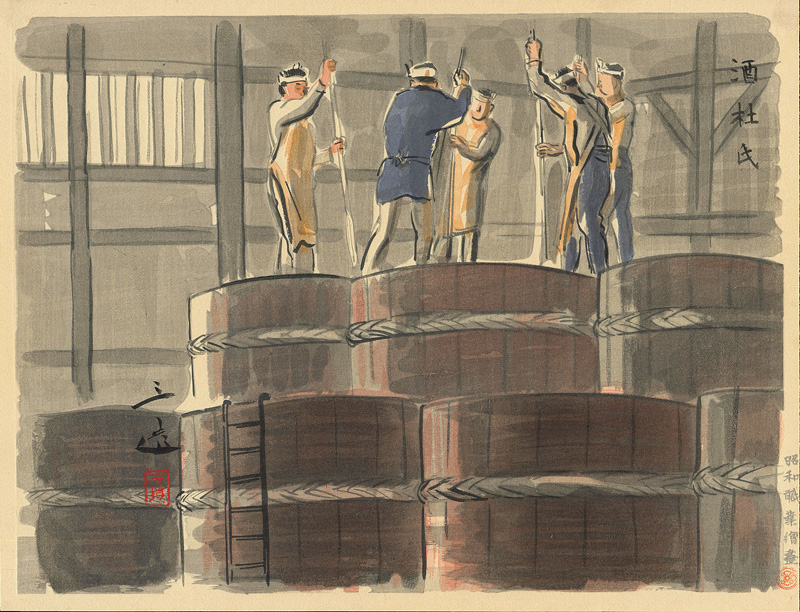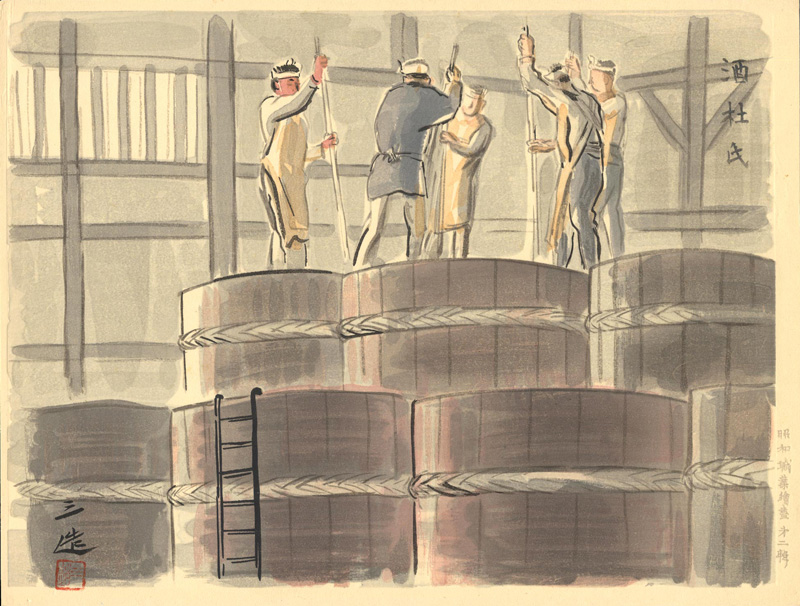About This Print
Five workers stir the mash during the fermentation process in this nineteenth print in the second series of Occupations of Shōwa Japan in Pictures, published by Nishinomiya Shoin between 1939 and 1941. While there is no sense of trouble brewing in this print, the Second Sino-Japanese War leading into World War II was a tough time for sake production, as the government began to tightly control distribution of rice for war efforts which led to the addition of pure alcohol and glucose to the rice mash before pressing to improve the yield.
[First Edition, 1939-1941, published by Nishinomiya Shoin]
[Translation taken from Memories of Shōwa: Impressions of Working Life by Wada Sanzō,
Maureen de Vries and Daphne van der Molen, Nihon no hanga, 2021, p. 59.]
The Sake Brewer
I have been wondering for a long time about the strangeness of the fact we call the person making the sake a 'brewer'. When I looked it up in the dictionary it was described in roughly the following manner.
One explanation is that 'brewer', 'master brewer', and 'sake brewer' all originate from older terms such as 'god of the sake jar'. According to other series the person, by the name of Du Kang, preparing the sake at the court of The Yellow Emperor long ago was called a brewer. And others seem to think it was a kind of nickname.
Some think that the original brewers came from Tanba, and that from this region they moved with the season to other regions. That it is a name that referred to a group of artisans who worked away from home every year to take on the whole brewing process, from washing barrels and rice to the eventual brewing of the end product.
Note that the print on the right carries the series number 第二輯 beneath the series title in the right margin.Usually only the series title is present in the right margin on the first edition Nishomiya Shoin issued prints.
About the Series "Occupations of Shōwa Japan in Pictures"
Sources: website of Ross Walker Ohmi Gallery http://www.ohmigallery.com/DB/Artists/Sales/Wada_Sanzo.asp and website of USC Pacific Asian Museum "Exhibition - The Occupations of Shōwa Japan in Pictures: The Woodblock Prints of Wada Sanzō"
Note:
My special thanks to Shinagawa Daiwa, the current owner of Kyoto Hangain, for providing the below information (in a series of emails in July 2014) about Nishinomiya Shoin and Kyoto Hangain, both businesses started by his father Shinagawa Kyoomi. Shinagawa's current website can be accessed at http://www.amy.hi-ho.ne.jp/kyotohangain/
2 "Out of the Dark Valley: Japanese Woodblock Prints and War, 1937-1945," Kendall H. Brown,p. 82 appearing in Impressions, The Journal of the Ukiyo-e Society of America, Inc., Number 23, 2001.
3 Pacific Asia Museum website http://www.pacificasiamuseum.org/_on_view/exhibitions/2004/occshowa.aspx
4 Light in Darkness: Women in Japanese Prints of Early Shōwa (1926-1945), Kendall H. Brown, et. al., Fisher Gallery, University of Southern California, 1996, p. 18.
| IHL Catalog | #973 |
| Title/Description | 酒杜氏 [saketoji] - Sake Distillers [number 19] |
| Series | Occupations of Shōwa Japan in Pictures, Series 2 (also seen translated as "Compendium of Occupations in the Shōwa Era" and "Japanese Vocations in Pictures") Shōwa shokugyō e-zukushi 昭和職業繪盡 (also seen written as 昭和職業絵尽し and 昭和職業繪盡し) dainishū (第二輯) |
| Artist | Wada Sanzō (1883-1967) |
| Signature | 三造 Sanzō |
| Seal |  |
| Publication Date | 1939-1941 |
| Publisher |  |
| Edition | first edition |
| Impression | excellent |
| Colors | excellent |
| Condition | excellent - wrinkling in top corners caused by removal from original folio; slight toning |
| Genre | shin hanga |
| Miscellaneous | originally released by Nishinomiya Shoin as print number 19 in series 2 |
| Format | dai-oban |
| H x W Paper | 11 1/4 x 14 7/8 in. (28.6 x 37.8 cm) |
| H x W Image | 10 3/4 x 14 1/2 in. (27.3 x 36.8 cm) |
| Collections This Print | Himeji City Museum of Art Ⅲ-184-19 (dated "1939~1940年") |
| Reference Literature | Memories of Shōwa: Impressions of Working Life by Wada Sanzō, Maureen de Vries and Daphne van der Molen, Nihon no hanga, 2021 |




